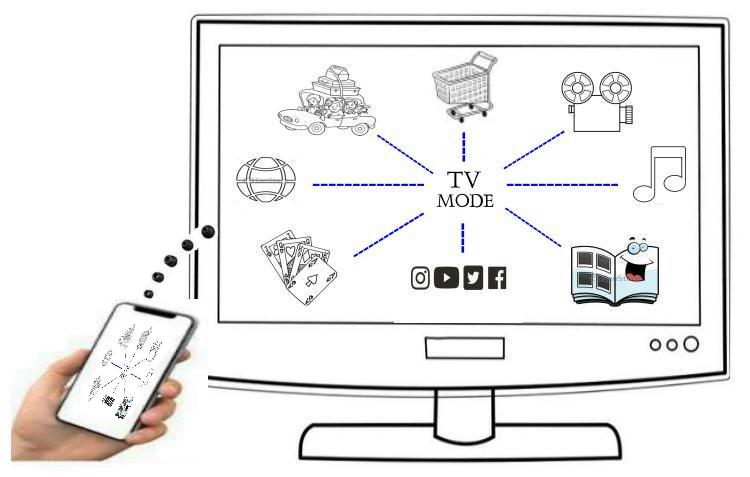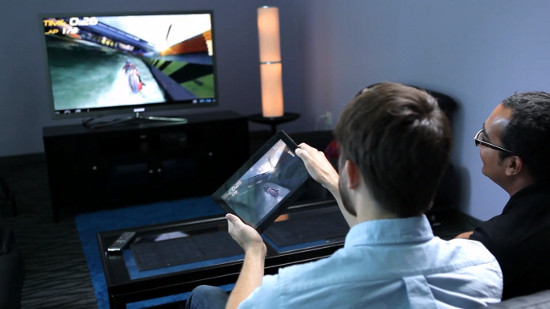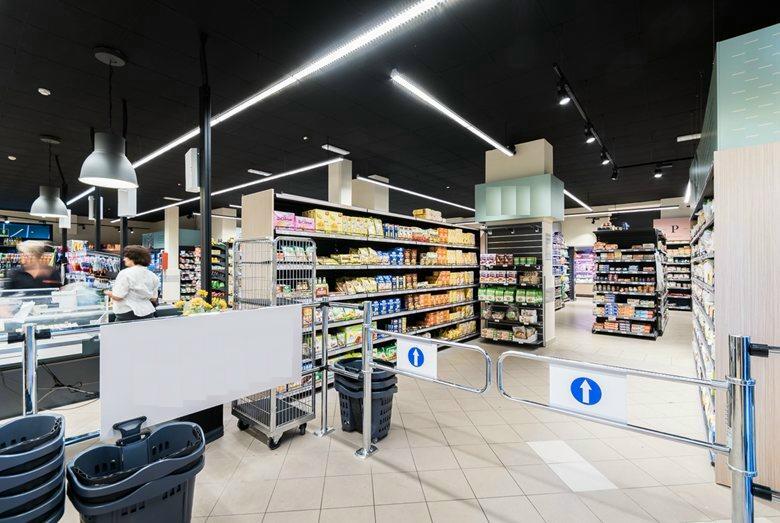TV mode “Supermercato virtuale” su piattaforma multiservizi
1. Nome del progetto
2. Concetti principali
3. Distribuzione
4. Fatturato
5. Attuazione del progetto
6. Costi di implementazione
Guarda il video in Italiano
Watch the video in English
1. Nome del progetto: TV mode
Il progetto, come si può vedere dal nome, coinvolge la TV, dove l’apparecchio televisivo è utilizzato per visualizzare il tour e rendere multiutente, più fruibile e inclusiva l’intera piattaforma TV mode.
E’ possibile usare la piattaforma anche sullo smartphone o tablet, perdendo un poco di inclusività dovuta alle ridotte dimensione dei display dei device rispetto alla TV.
— Home dell’applicazione

2. Concetti principali
Tutti gli operatori del settore alimentare al dettaglio hanno, oltre ai centri commerciali, siti Web in cui è possibile effettuare acquisti, un PC o un tablet e nozioni di base di informatica sono chiaramente richiesti.
In quei siti Web, i prodotti sono elencati per tipo, qualità, prezzo e visualizzati per pagine, per il cliente questo metodo è decisamente impegnativo perché non ha una visione chiara di tutti i prodotti, o almeno, non nel modo in cui potrebbe averlo se fosse davanti agli scaffali di un supermercato fisico.
Lo scopo del progetto è quello di creare un video interattivo di un centro commerciale, dove il cliente può “percorrere” i corridoi con il suo carrello della spesa, proprio come farebbe se si trovasse in un supermercato fisico.
Con TVmode, il cliente cerca i prodotti di cui ha bisogno nei corridoi proprio come nella realtà, prende ciò che gli interessa direttamente dallo scaffale o dal frigo e lo mette carrello, una volta terminati gli acquisti procede verso l’uscita e la spesa gli verrà consegnata a casa da un fattorino nella fascia oraria richiesta.
Grazie al video interattivo, il cliente può verificare le caratteristiche organolettiche dei prodotti, le date di scadenza e il paese di provenienza.
I pagamenti possono essere effettuati quando il fattorino arriva a casa, tramite POS wi-fi o addebito bancario RID.
TVmode offre la possibilità di fare acquisti a qualsiasi ora, di controllare senza fretta tutti gli sconti e le offerte, di ottimizzare il bilancio famigliare evitando gli sprechi.
E’ possibile risolvere una situazione improvvisa come una cena o un barbecue organizzati all’ultimo momento, dove reperire tutto ciò che serve può generare stress e perdite di tempo tali da pregiudicare il tranquillo svolgersi della serata.
La qualità del filmato e la risoluzione degli apparecchi TV oggi in commercio, rendono gli acquisti molto semplici e gradevoli, senza allontanarsi dal proprio domicilio, ci si trova proiettati in un grande cento commerciale accattivante, funzionale e coinvolgente proprio come avviene in un centro fisico.
Non necessitando della costruzione di centri commerciali, acquisizione di aree e ottenimento di permessi dalle amministrazioni territoriali, le spese di impianto risultano molto contenute e quindi l’offerta delle merci non è gravata dei costi finanziari.
In pratica il sistema restituisce al cliente qualcosa che nessun operatore della grande distribuzione può dare: il tempo.
Come precedentemente detto, tutte le soluzioni di acquisto online necessitano di PC o Tablet nel caso del TVmode occorre una TV e uno smartphone, apparecchi che oggi hanno praticamente tutti.
Il display dello smartphone è utilizzato per interagire con il tour, diventando una sorta di mouse praticamente come già avviene, ad esempio, con la funzione “street view” di Google Maps.
L’utilizzo molto facile e intuitivo è adatto a qualsiasi età, in caso però, di anziani poco inclini alle nuove tecnologie o persone con disabilità, viene fornito un tutor online per aiutarli nella navigazione e dare loro consigli.
– Perché la TV?
Viene usata la TV perché più persone possano vedere il tour simultaneamente e in grande formato, rendendo così possibile il coinvolgimento dell’intera famiglia, proprio come avviene nei centri commerciali fisici, ma stando comodamente a casa.
Evitare l’uso delle auto per recarsi nei centri commerciali, riduce i fattori di rischio di incidenti, condizioni meteorologiche avverse come pioggia, nebbia, neve o ghiaccio e le sostanze inquinanti emesse nell’aria sono molto ridimensionate.
Ad esempio, ipotizzando che 1.000 auto, Euro 5 con scarico in atmosfera di circa 100 gr a km, circolino in un giorno sulle strade per raggiungere un centro commerciale e che ciascuna percorra di media circa 10 km, si sarà evitato una immissione di 1.000 kg di inquinanti, certo non poca cosa.
Altro utilizzo del sistema è che può diventare uno strumento utile per il tempo libero:
Guardare insieme e commentare una ricerca su internet, ad esempio, cercare una soluzione per le vacanze, vedere le offerte, apprezzare la galleria fotografica in grande formato sullo schermo della TV
Condividere l’album fotografico dell’ ultimo viaggio con i tuoi amici e famigliari
Condividere il tuo pensiero del momento sui social media preferiti
Vedere un film sul Web senza bisogno di decoder, schede o altre installazioni
Ascoltare la tua musica preferita, esempio sfruttando l’home theater del Tv se presente.
- E’ possibile usarlo anche come assistente vocale, senza dover ricorrere a altre apparecchiature presenti sul mercato, usufruire di skill che permettono di comporre un carrello della spesa, di interfacciarsi con device domotici e gestire attività con il solo comando vocale.
Fondamentalmente, permette di trasformare una semplice TV in una smartTV eliminando i problemi di driver o configurazioni, di integrare funzioni di domotica e in particolare di usare a piacimento connessioni wifi o traffico dati senza alcuna limitazione, che invece troviamo nelle soluzioni di mercato come chromecast o miracast.

:max_bytes(150000):strip_icc()/GettyImages-screen-mirroring-842272124-5a7897e104d1cf0037763c0a.jpg)
3. Distribuzione
La distribuzione tra la popolazione è molto semplice perché il cliente deve solo scaricare il tour virtuale, collegare il ricevitore Wi-Fi nello slot del televisore, tutto il resto è intuitivo e scorrevole.
Inizialmente il sistema è destinato alle aree urbane ad alta densità di popolazione al fine di pianificare le consegne e ottimizzarle per quartiere in modo contenere i costi e i tempi di consegna delle merci, successivamente piattaforme di distribuzione decentrate potranno servire centri abitati minori.
4. Fatturato
La stima della “spesa settimanale” di una famiglia media di quattro persone è di circa 180 €.
Ipotizzando di fidelizzare circa 4 milioni di famiglie e supponendo che il servizio di spesa virtuale sia utilizzato dal 50% degli utenti, il risultato è facile da trovare.
Il servizio può essere esteso anche a piccoli ristoranti, pizzerie, mense, che per la fornitura di materie prime, spendono diverse ore/persona il giorno.
Il ritorno economico derivante dal servizio offerto agli operatori professionali è difficilmente quantificabile.
Ricavi provenienti da affitto di spazi virtuali a operatori diversi non sono stati considerati.
5. Attuazione del progetto
Per realizzare il progetto sono necessari quattro punti chiave:
1) una struttura software, preferibilmente interna, per sviluppare il tour virtuale, le skill e gli aggiornamenti necessari oltre la gestione dei flussi degli ordinativi
2) l’acquisizione dei dispositivi ricevitore wireless, adattatore usb da fornire in comodato d’uso ai clienti
3) organizzazione e gestione delle piattaforme per la consegna di merci
4) organizzazione degli addetti alle consegne a domicilio
6. Costi di implementazione (riferimento al paragrafo 5)
I costi al punto 1) sono quantificabili nella struttura, nei server, negli stipendi degli operatori e degli sviluppatori.
I costi al punto 2) sono di circa 4 € acquistandone uno. Chiaramente con l’acquisto di alcuni milioni di pezzi, il prezzo diminuisce drasticamente.
I costi al punto 3) sono variabili e determinati dalle decisioni manageriali, vale a dire:
ci si vuole dotare di magazzini automatici (es. Amazon) o tradizionali, si vogliono affittare strutture esistenti o acquisirne di nuove
Devono essere aggiunti i costi per la struttura direzionale e gestionale.
I costi al punto 4) dipendono dalle politiche aziendali
Considerazioni e riferimenti
Alcune catene GDO cercano di fidelizzare il cliente con sconti a macchia di leopardo, offrono carte fedeltà; ma cosa chiede il cliente tipo?
E in particolare, cosa ne pensano le donne della spesa online?
http://www.unadonna.it/lifestyle/fare-meglio-la-spesa-al-supermercato-e-online/13724/
https://www.mammafelice.it/2010/01/28/fare-la-spesa-online/
Giuliano Noci – Politecnico di Milano, Il retail deve ragionare sul lungo periodo
Quanti Italiani vanno su internet per lo shopping?
Cosa pensano o temono i retailer del futuro?
Per Ultimo:
La piattaforma è ampliabile e il servizio può essere esteso a operatori terzi, a cui affittare negozi virtuali, come Es.
Telefonia mobile (vende apparecchi e soluzioni di traffico)
Pay Tv (può fornire il servizio attraverso la piattaforma senza dover gestire decoder da fornire per fruirne)
Giochi online (permetterne l’uso da Smartphone senza dotarsi di apparecchi aggiuntivi.
Lo stato attuale del progetto è:
- Sviluppato test di valutazione
- Brevettato nella forma e nel metodo
Cerco investitori attivi, o meglio, persone che possano apportare oltre i necessari flussi di denaro, l’esperienza commerciale necessaria per la realizzazione del progetto.
Contatto:
dinomatello@gmail.com
